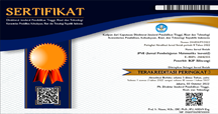PENERAPAN PENDEKATAN PROBLEM POSSING UNTUK MENINGKATKAN KEMAMPUAN PEMECAHAN MASALAH MATEMATIS SISWA SMP
DOI:
https://doi.org/10.22460/jpmi.v3i1.p27-34Keywords:
Problem Possing Approach, Problem Solving AbilityAbstract
The research aims to determine the enhancement of students ' mathematical problem solving skills. This research uses experimental methods. The population is a class VII junior high, while the sampling is a class VII one of the junior high schools in Cimahi, consisting of two classes, the VII E class being an experimental class while the VII D became the control class. Both classes were given pretes at the beginning of the meeting and Postes at the end of the meeting. The instrument used is 5 items about the mathematical troubleshooting description. Based on the Mann Whitney non parametric test that acquired significance was 0.000. The conclusion that resulted in this research is the enhancement of mathematical problem solving skills of students who are using the approach of possing problem better than using scientific approach. Learning using the approach trains the students in making problems and answering them so that mathematical problem-solving skills can increase.
References
Adelia, W. S., & Primandari, A. H. (2017). Upaya Meningkatkan Kemampuan Pemecahan Masalah Siswa Kelas Viii-a Smp N 2 Nanggulan Dalam Pembelajaran Menggunakan Model Pembelajaran Kooperatif Tipe Think-Pair-Square, 240–254.
Anwar, & Zaki, M. (2017). Anwar dan Muhammad Zaki, Penerapan Pendekatan Problem... Numeracy Journal, 4(2), 90–98.
Ardiyaningrum, M. (2016). Upaya Peningkatan Kemampuan Pemecahan Masalah Matematis Siswa Kelas Vii Smp Muhammadiyah 9 Yogyakarta Melalui Penerapan Pendekatan Pembelajaran Problem Posing. LITERASI (Jurnal Ilmu Pendidikan), 4(1), 53. https://doi.org/10.21927/literasi.2013.4(1).53-70
Aripin, U. (2015). P2M STKIP Siliwangi P2M STKIP Siliwangi. Jurnal Ilmiah UPT P2M STKIP Siliwangi, 2(1), 128–136. https://doi.org/10.1523/JNEUROSCI.2378-09.2009
Aripin, U., & Alifah, N. (2018). Proses Berpikir Siswa SMP dalam Memecahkan Masalah Matematika ditinjau dari Kognitif Field Dependent dan Field Indepennt. Jurnal Pembelajaran Matematika Inovatif, 1(4), 505–512.
Herawati, O. D. P., Siroj, R., & Basir, D. (2013). Pengaruh Pembelajaran Problem Posing Terhadap Kemampuan Pemahaman Konsep Matematika Siswa Kelas Xi Ipa Sma Negeri 6 Palembang. Jurnal Pendidikan Matematika, 4(1). https://doi.org/10.22342/jpm.4.1.312.
Indahsari, I. N., Situmorang, J. C., & Amelia, R. (2019). Analisis kemampuan pemecahan masalah matematis dan self efficacy siswa man. Journal On Education, 01(02), 256–264.
Lestari, D. (2013). Penerapan Teori Bruner Untuk Meningkatkan Hasil Belajar Siswa Pada Pembelajaran Simetri Lipat di Kelas IV SDN 02 Makmur Jaya Kabupaten Mamuju Utara. Jurnal Kreatif Tadulako, 3(2), 129–141. Retrieved from https://media.neliti.com/media/publications/121377-ID-penerapan-teori-bruner-untuk-meningkatka.pdf
Mulyanti, N. R., Yani, N., & Amelia, R. (2018). Analisis kesulitan siswa dalam pemecahan masalah matematik siswa smp pada materi teorema phytagoras. JPMI (Jurnal Pembelajaran Matematika Inovatif), 1(3), 415–426. https://doi.org/10.22460/jpmi.v1i3.415-426
Muzaini, M. (2017). Pengaruh Pendekatan Problem Posing Terhadap Prestasi Belajar Matematika Siswa Berdasarkan Gaya Kognitif. Beta Jurnal Tadris Matematika, 9(2), 161. https://doi.org/10.20414/betajtm.v9i2.13
Nurcahyo, N. (2014). PENDEKATAN PROBLEM POSING UNTUK MENINGKATKAN KEMAMPUAN PEMECAHAN MASALAH DAN PENGAJUAN MASALAH MATEMATIS SERTA HABITS OF MIND SISWA SMA. Retrieved from http://repository.upi.edu/13508/
Ruseffendi, E. T. (2010). Dasar-dasar Penelitian Pendidikan dan Bidang Non-eksakta Lainnya Bagi Para Peneliti, Penulis Skripsi, Penulis Thesis, Penulis Disertasi, Dosen Metode Penelitian,dan Mahasiswa. Bandung: Tarsito.
Septi, D., & Afifah, N. (2017). Pendekatan Problem Posing. Jurnal Gamatika, 2(2), 157–165.

















